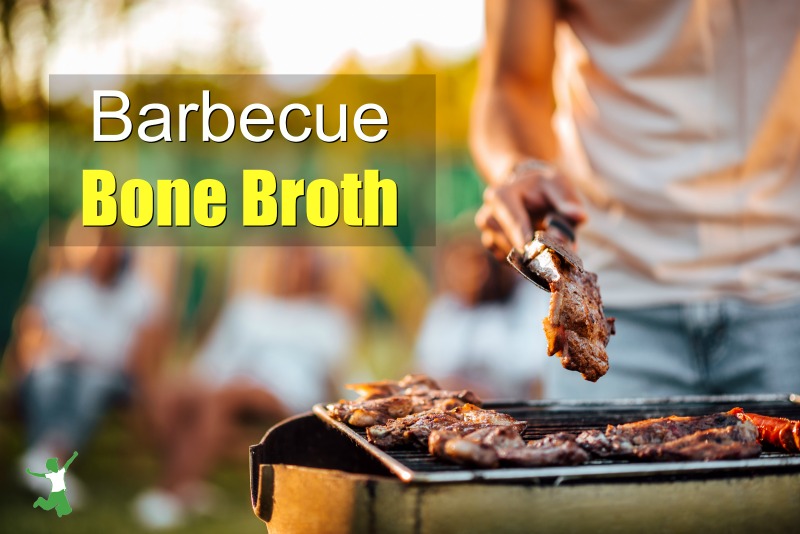Barbecue bone broth is an unforgettable smokey flavored stock that is delicious and rich sipped on its own or as a base for homemade soups and sauces.

A tummy bug is going around our local community at the moment, so it’s no surprise that our family is going through a lot of chicken and beef broth to shore up our resistance and/or ensure rapid recovery should it come a-knocking at our door!
To mix things up, making barbecue bone broth with its unforgettable smoky flavor, is sure to stimulate appetite exhausted from illness.
The copious amounts of natural gelatin in broth, if you recall, serve to deter gastrointestinal bugs from attaching to the gut wall and wreaking havoc in the form of vomiting and diarrhea. Homemade broth is quite simply an indispensable tool in your wellness toolbox during flu season!
This time of year, when colds, flu, and other viruses are running rampant, I must admit that my family gets rather tired of broth as it seems to be a nearly constant feature on the menu.
I do my best to make soups and sauces with my homemade stock, but when you need to consume a lot of broth in any given day, sometimes just a cup of it with a bit of sea salt is the quickest way to get the job done.
Barbecue Bone Broth
Needless to say, I was thrilled when I found a very creative recipe for Barbecue Bone Broth in my friend Stanley Fishman’s brand spanking new book Tender Grassfed Barbecue: Traditional, Primal, and Paleo!
This book, by the way, would make a great holiday gift for that barbecuing whiz in your home who likes to take charge at the grill (husbands, that would be YOU)!
Barbecue bone broth with a smoky flavor! What a great idea for mixing things up!

Barbecue Bone Broth Recipe
Recipe for barbecue bone broth, an unforgettable smokey flavored stock that is delicious and rich sipped on its own or as a base for homemade soups and sauces.720
Ingredients
- 4-6 lbs barbecue bones, meat scraps and trimmings any combination of meat and bones from grassfed animals will do
- 4 stalks celery coarsely chopped, preferably organic
- 6 green onions coarsely chopped, preferably organic
- 4 large carrots peeled and chopped, preferably organic
- 4 cloves garlic peeled and chopped, preferably organic
- 2 Tbl sea salt coarse and unrefined
- filtered water enough to cover bones by 2-3 inches
Instructions
-
Put the meat and bones into a large stockpot. Add the water. Add all the vegetables. Heat the pot until the water begins a strong simmer. This will take awhile due to the large volume of ingredients and water.
-
When the water is close to boiling, remove all the scum that rises to the top with a skimming spoon. This can also take a few minutes, but it is necessary for the best tasting broth.
-
Once the scum is removed from the pot of barbecue bone broth, add the sea salt.
-
Cover and simmer gently for 12 hours.
-
Using a ladle, strain into jars, cover, and refrigerate once the bottles have cooled down. The fat will rise to the top and will solidify in the refrigerator. This fat seal will help preserve the broth.
-
The fat should be removed before the broth is reheated. It can be used as a healthy cooking fat in all kinds of dishes.

Source: Tender Grassfed Barbecue: Traditional, Primal, Paleo, by Stanley A. Fishman, p. 52.








I love this idea!!!
usually when I eat chicken with bones, there is not much left of the bone, I crush it and suck it dry, so not point using that again 🙂
We love all our different broths, but using smoked chicken/turkey or a beef roast makes it simply incredibly! Sometimes we’ll have to thin it down w/some “regular” broth, the flavor is so rich.
Steaming veggies (especially green beans) in a bit of smokey broth is amazing! The kids fight over them.
We have also used smoked turkey and the broth is incredible
I have! Barbequed rib bones are awesome for broth!
I’m pretty new to the bone broth making – and by following your instructions, I was able to make beef broth that gelled on my first try!
We smoke a turkey a few times a year. I make stock with the carcass. The last time I did it my husband kept asking if I was serving ham because the smokiness of the broth was so similar to the flavor of a smoked ham. It was kinda funny saying that it was a casserole of turkey “ham” or chicken “ham” or beef “ham”.
Good stuff…gonna share!
It’s yummy for a shrimp soup with some frozen peppers! 🙂
I always make broth out of our leftover chicken bones just because it’s yummy and saves money, but the health benefits of the gelatin are news to me. Thanks for sharing. 🙂